Side Menu:
Fourth Officer Joseph Boxhall
- The US & British Inquiries
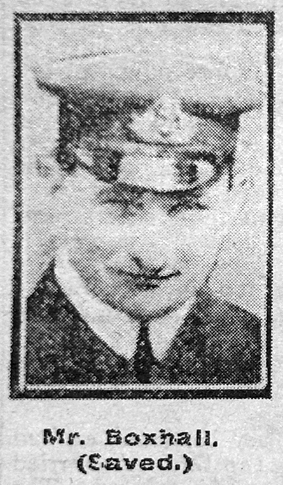
Boxhall as pictured in the 18th of April 1912
Daily Mirror.
On the 16th of April 1912, there was already concern at home in Hull, with the local Daily Mail reporting: "The Titanc had on board an officer, a young man, whose family is extremely well-known and highly respected in the city. This is Mr Joseph Groves Boxhall... Many of Boxhall's friends will be anxiously awaiting news of his survival. He is described as a wonderfully smart young officer and come of an old Hull seafaring family." (Daily Mail, Hull, Humberside, 16 Apr 1912, Tue, p.10)
The Carpathia arrived at Pier 54, New York with all the survivors from the Titanic, on the evening of 18th April 1912. Immediately upon arrival the surviving officers, including Boxhall, and the crew, along with Bruce Ismay were served with subpoenas.
According to The New York Times of April 19, 1912, under the heading of "Four Surviving Officers - Committee Tells Them Not to Talk - Seek Refuge on Lapland" - when Senator Smith and Senator Newlands arrived in New York at 9pm on the 18th they went straight to the pier where the Carpathia had just arrived and "served subpoenas right and left... The subpoenas were all returnable at the Waldorf to-day at 10 o'clock... The Titanic's four rescued officers were placed aboard the Red Star liner Lapland for the night. They refused to talk, saying they were under instructions to give no information except to the Senate committee." (The New York Times, April 19, 1912)
Boxhall is Ill
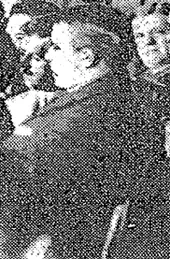
A close up from an American
Press Association photograph
of Boxhall testifying before
the Senate, 22 April 1912.
According to a later press report, Boxhall arrived "in pain since landing in New York." (Washington Times, April 23rd 1912). Wasting no time, the hearings began on April 19th, 1912, at the Waldorf-Astoria Hotel, New York, the day after their arrival. On the Sunday, the inquiries moved to Washington and on April 21st, Boxhall visited Dr. Charles C. Marbury, M.D. explaining that he had been in pain since arriving in the US.
However, despite this Boxhall testified on the 3rd day of the US Inquiry, on Monday April 22, 1912. "He seemed unwell, but decline an invitation to be seated." (The Newcastle Daily Chronicle, 23 May 1912, page 5). The Daily Telegraph reported that Boxhall was "a man of pale and ascetic mien, who looked rather weakly, but who courteously declined to take the chair that was offered to him whilst he gave his evidence. A thoughtful, observant, mehtodical man this, of a surety." (The Daily Telegraph, 23 May 1912, page 8) From 3pm he answered around 900 questions and spoke roughly 8,000 words during a 3 hour long session which took up so much time that he was the only survivor who testified that day. It was not until 6.20pm before they decided to finish questioning him. The atmosphere on this day was also allegedly intense, with press reporting that the room he testified in was packed with about 1,000 people and it was so over crowded that the atmosphere inside was 'suffocating' and there were constant interruptions because of the noise.
According to Wyn Wade's book "End of a Dream": "Boxhall was a clean cut young man, 'small, delicate-looking', with coal-black hair. He seemed exceptionaly nervous. He kept his hands firmly clasped so they wouldn't tremble and spoke so softly that constant repeats and calls for 'louder' were necessary..."
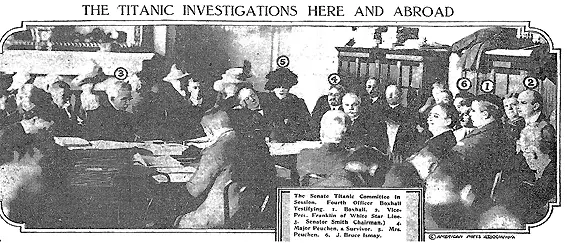
A rare photograph of Fourth Officer Boxhall testifying at the Senate Inquiry in Washington. He is identified by the number 1. -The New York Times, April 28, 1912.
(Click image to enlarge)
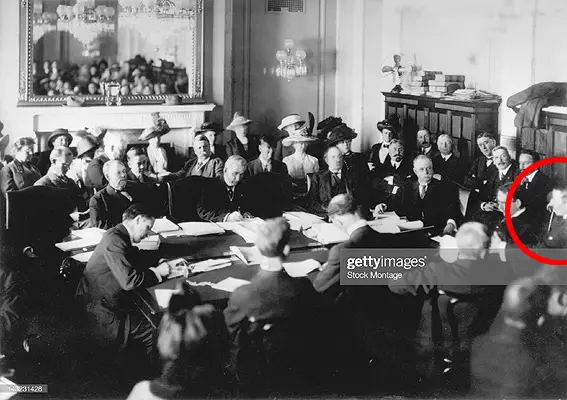
In this very similar photograph from Getty Images, is this also during Boxhall's testimony? In which case is that Boxhall almost cut off on the far right hand side (circled)? (Click image to enlarge)
Another newspaper report said that there was a "statement made under oath by Joseph G Boxhall, fourth officer of the Titanic" on the "first day's session of the committee held in the national capital. When the fourth officer told his story, the throng of almost 600 who crowded to its capacity the beautiful marble conference room of the new senate office building, listened spellbound to his every word, straining forward eagerly in their chairs." (The Weekly Courier, Fort Collins Colorado, April 26, 1912)
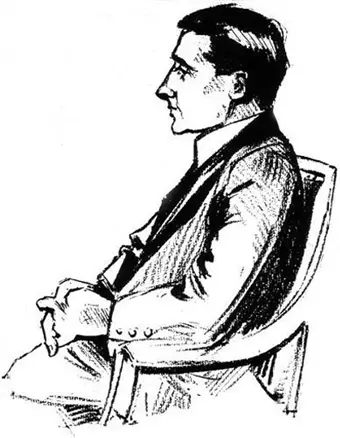
An artist's sketch of Boxhall testifying before the Senate.
The press particularly picked up on Boxhall's revelation of a nearby ship that did not respond, for example writing: "Not the slightest whisper had gone fourth concerning what Boxhall would testify to, and his every word fell upon the multitude crowded in the marble conference room of the Senate Office Building as lightning flashes from a clear sky." (The Daily New Era - Lancaster, Pennsylvania, 23 Apr 1912)
However the "multitude crowded in the marble conference room" became an issue and the following day, Tuesday April 23rd, 1912, the public were excluded from the hearing:
"Owing to the great confusion caused by the rush of the crowds to the hearing and the constant interruptions during the interrogation of witnesses, the Senate committee determined today to exclude the general public. To accomplish this the hearing was transferred to a smaller room in the Senate office building. Only witnesses, those particularly interested in the inquiry and members of the press were admitted to the room. The change caused disappointment to thousands, most of them women who crowded about the corridors leading to the marble caucus room as early as 8:30 o'clock. When officers later informed the crowd that the plans had been changed and the general public would be excluded be-cause of the confusion caused yester-day there were loud protests. Hundreds remained about the building clamoring for admittance. The crowd lined the hallways leading to the new room and the police had difficulty keeping a passageway to the door. (The Daily New Era - Lancaster, Pennsylvania, 23 Apr 1912)
But this change in format perhaps came too late for Boxhall, whose health was suffering. Boxhall was scheduled to continue his examination at 10am. But Boxhall was not present. Senator Smith began the proceedings by explaining: "When we closed the hearing yesterday afternoon Mr. Boxhall, the third [sic] officer of the Titanic, was on the stand. It had been the intention of the committee to recall him this morning and the reason for not doing so is the following note:
APRIL 23, 1912.
This is to certify that Mr. J. B. Boxhall, third [sic] officer of the Titanic, is under my professional care and treatment and that, in my opinion, he is physically unable to appear before the Senate investigating committee to-day.
CHARLES C. MARBURY, M.D. (US Inquiry)
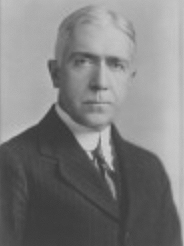
Dr Charles Marbury, M.D. sent
a note to the Senate stating
that Boxhall "is physically unable
to appear."
Instead of continuing the questioning of Boxhall they instead asked Third officer Pitman to take the stand. Dr Marbury was approached by a reporter from the Washington Times and the following day this article was published:
Boxhall Suffering from Pleurisy and Confined to Room
"Jerry [sic] B. Boxhall is suffering from an attach [sic] of pleurisy, brought on from exposure and exertion."' said Dr. C. C. Marbury, his attending physician, when asked as to the nature of the ailment that has prevented one of the leading witnesses to be examined by the Senate committee in the investigation of the Titanic disaster, from appearing before the committee today.
Dr. Marbury Issued a certificate today, stating that Boxhall was not in a fit physical condition to appear before the committee, causing important changes in the conducting of the investigation.
"Boxhall is confined to his bed at the Continental Hotel," continued Dr. Marbury. "He first came to me Sunday. saying that he had been In pain since landing In New York. Yesterday he had considerable fever, although that has been abated today. It is more than probable that he will be able to be about in a day or two."
It was the extreme exertion of rowing one of the lifeboats that he had been detailed to man that brought the pleurisy upon Boxhall. This was aggravated by the exposure which followed while sitting in the uncovered boat in the open sea after the sinking of the Titanic and before the rescue by the Carpathia.
According to Titanic researcher and author Inger Sheil, living relatives of Boxhall later "stressed to me that it was the events after the sinking - being in an open boat and the lack of time to recuperate on the Carpathia - that exacerbated the illness, although it still remains unclear whether there was a pre-existing condition. Rather than an opportunity to recover, the last leg of the journey to New York saw the Titanic's officers working alongside their Cunard brethren...it would have been stressful enough without the need to be on duty. I recall Bissett's haunting description of coming up on deck and finding the Titanic's officers also unable to sleep, going over the events of the sinking." (Encyclopedia Titanica, 2002)
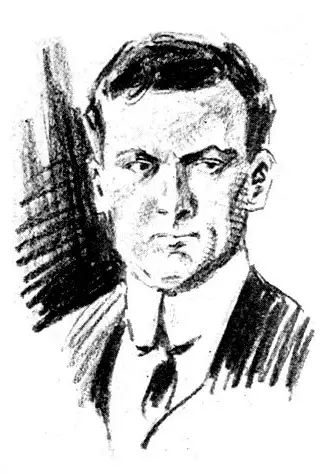
Another courtroom sketch of Boxhall at the
Senate Inquiry, looking decidely unhappy.
Second officer Lightoller wrote a letter to Ada Murdoch in Southampton, the widow of First officer Murdoch, dated April 24th, 1912 and co-signed by the three other surviving officers, Boxhall, Pitman and Lowe. So it seems Lightoller had some contact with Boxhall on the 23rd/24th, as they were staying in the same hotel - the Washington Continental Hotel.
On Thursday April 25th, Senators Smith (chairman), Burton, Perkins, and Fletcher met at 10.15 am and asked about Boxhall's whereabouts:
Senator SMITH. I would like to know if Mr. Boxhall, the fourth officer of the Titanic is present?
Mr. CORNELIUS. He is not here, sir. He is in bed.
Senator SMITH. I want to know, officially, that he is. Can you give any announcement as to Mr. Boxhall, Mr. Burlingham?
Mr. BURLINGHAM. Mr. Lightoller says that he is still sick in bed, Mr. Chairman.
Senator SMITH. And unable to be present this morning?
Mr. BURLINGHAM. He cannot be here today. We hope he will be able to come to-morrow or the next day, at the latest.
Senator SMITH. Officer Lightoller, you know of the illness of Mr. Boxhall?
Mr. LIGHTOLLER. Yes, sir.
Senator SMITH. Your fellow officer?
Mr. LIGHTOLLER. Yes, sir.
Senator SMITH. You have seen him this morning?
Mr. LIGHTOLLER. Yes, sir.
Senator SMITH. And you say he is unable to respond to the call of the committee this morning?
Mr. LIGHTOLLER. As far as I know from the doctor; yes, sir.
Senator SMITH. That is all.
A week later, his condition had improved sufficiently enough to allow him to resume testifying on Monday April 29th, 1912, day ten of the Senate Inquiry, during the afternoon and during which he confirmed he "did not hear of any ice reports the day of the accident." (US Inquiry)
Later on the evening of the 29th, at about 6.20pm, he was separately questioned before Senator Burton in a room downstairs from where the main Senate Inquiry was taking place. This was based on Senator Smith's instruction: "Mr. Boxhall would care to call upon Senator Burton this evening, he might be able to get through with him."
During this examination Senator Burton asked: "What did Murdoch mean by the expression "I intended to port around it?" What is the meaning of that expression?" Boxhall replied "That is easier described than explained." Boxhall then went on to draw a diagram to describe the meaning of the term. The separate questioning finished at 7.10pm. That was the last of his testimony at the Senate Inquiry.
Escape on the Adriatic
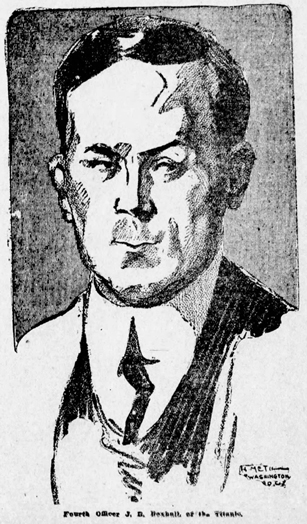
A court sketch published in the The Times Dispatch
(Richmond, Virginia), 24 April 1912,
page 8. (Click image to enlarge)
At midday Thursday May the 2nd, 1912,Boxhall, along with the three other surviving officers, thirty crew members, and White Star President Bruce Ismay, were able to depart for England, boarding the Adriatic from New York City. They arrived in Liverpool, UK on 11 May, 1912.
Boxhall was fortunate to make the Adriatic - he, along with Ismay and Lightoller, had been served with subpoenas by the District Supreme Court to give evidence on an affidavit by a Mrs Louise Roberts, the wife of John Jacob Astor’s valet, who was preparing a suit for damages against the White Star Line. When threatened with legal action for departing DC to go to NY, it was argued that he could not be subpoenaed again within 24 hours of the US Congressional Inquiry having released him. Legal representatives of the three men reached an agreement with the attorneys of Mrs Roberts that the men would return to America the following Autumn to give their testimony when the case came up.
However the press did not report on it favourably:
MAY BE HELD IN CONTEMPT OF FEDERAL COURT
And Two Officers of Titanic Refuse to Recognize Summons in Suit for Damage
Washington, April 30.—An action holding J. Bruce lsmay in contempt of federal court, together with Charles Lightoller and Joseph Box-hall, officer of the Titanic, will be instituted at once, it is said, as a result of their failure to recognize summons in a suit for damages filed here by Mrs. Louise Robbins, whose husband, a valet to Col. Astor, was drowned on the Titanic. Summons were to appear before the referee to testify for the purpose of preserving the testimony, should they leave the jurisdiction of the court. All three went to New York and the hearing, awaiting their attendance, was abandoned. The attorney for Mrs. Robins said he will ask an attachment for them. (The Twice-A-Week Messenger, Owensboro, Kentucky, 4 May 1912)
British Board of Trade Inquiry
The officers arrived back in England on the 11th of May, disembarking the Adriatic at Liverpool. An inquiry was instigated by the British Wreck Commissioner on behalf of the British Board of Trade, overseen by High Court judge Lord Mersey, and held in London from 2 May to 3 July 1912. The hearings took place mainly at the London Scottish Drill Hall, at 59 Buckingham Gate, London SW1. There were a total of 42 days of official investigation.
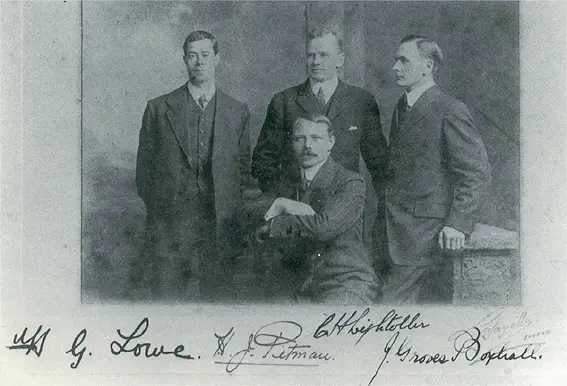
The four surviving Titanic officers, in a signed studio photograph, on their return to England. It is one of two only known photographs of the officers together. From left: Fifth officer Lowe, Third Officer Pitman, Second officer Lightoller and Fourth officer Boxhall. (Click image to enlarge)
Boxhall appeared on day 13 (Wednesday, May 22, 1912) and 14 (Thursday, May 23, 1912). During his appearance on the first day the Solicitor-General noted Boxhall's illness, saying "I fancy Mr. Boxhall has not been very well. I know your Lordship will allow him to sit down." The Commissioner responded by saying to Boxhall "Certainly, sit down, if you wish?" Boxhall replied: "I am quite right, my Lord, thank you." (British Inquiry)
Much of his testimony concerned details of the lifeboat lowerings and Titanic's navigation, including the many ice warnings. He was also the first person to testify that he saw another vessel in proximity while Titanic sank.
During his questioning on the first day Boxhall was instructed "to mark on that chart the place of ice as indicated by the “Caronia,” the “Amerika,” the “Baltic,” and the “Californian.” Later he added an ice warning position from the Mesaba which resulted in an "oblong" area on the chart.
Ice Positions:
Caronia 42 degrees N., from 49 to 51 W
Amerika 41° 27' N, 50° 8' W
Baltic 41° 51' N., long. 49° 52' W.
Californian 42º N., 49º 9' W.
Mesaba 42° N. to 41° 25' N., long. 49° to long. 50° 30' W.
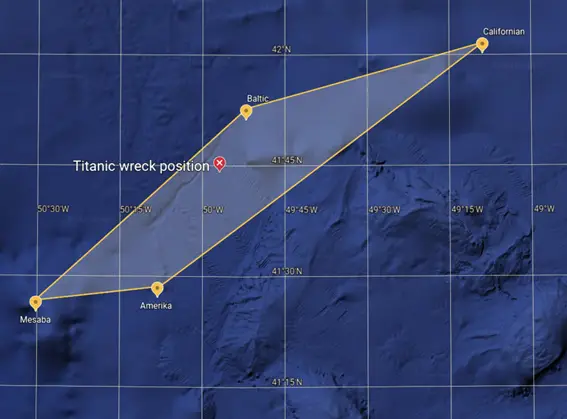
A recreation, based on the approximate iceberg positions, of the 'oblong' area that Boxhall drew on the chart at the Commissioner's instructions, compared with the sinking position. (Click image to enlarge)
The Commisioner stated: "Then to sum it up, if these messages were received and were in the terms that have been stated by the Solicitor-General, this steamer was steaming a course through an oblong space, having received warning that there were icebergs on the north of her and icebergs on the south of her?" Boxhall replies: "Yes, you are quite right in saying that the steamer sunk in that position. She sunk in that position."
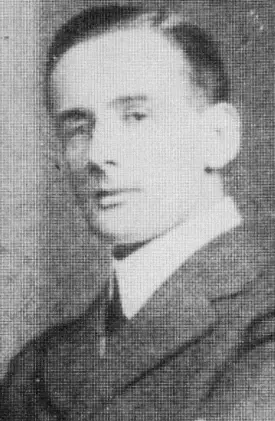
Joseph Boxhall in 1912.
The Commissioner then said: "But she steamed through it did not she for some time, until she met with her doom?" To which Boxhall confirmed: "Yes, she must have done." But then explained: " I do not think for a moment that we had those messages, my Lord."
Although perhaps the transcript does not reveal everything. According to a May 23, 1912 edition of The New York Times, under the headline of "Titanic Officer's Silence" Boxhall 'did not reply when asked why ice warnings were unheeded'. It stated:
"During Boxhall's examination the Solicitor-General went at some length into the wireless dispatches in the regard to ice received by the Titanic, information which it was Boxhall's duty to mark on the chart. Boxhall could not remember all the wireless dispatches received, but the Solicotor-General said that from those of which they already had evidence and others to be produced it was plain the warnings received from the Baltic, the Amerika, the Californian, and the Caronia all related to icebergs in the oblong space where Titanic met her fate. Lord Mersey asked the witness whether he could explain why, having recevied warnings of icerbgs both to the north and south of her, the Titanic was allowed to continue her way in such regions. The witness did not reply." (The New York Times, May 23, 1912)
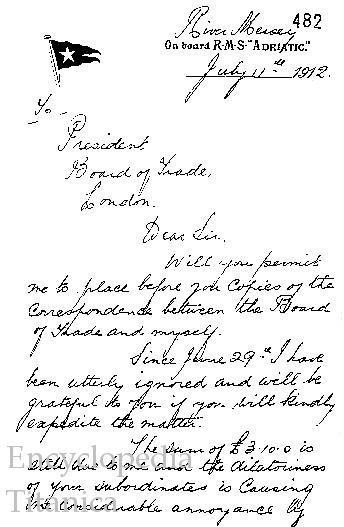
Boxhall's letter to the British Board of Trade. (Encyclopedia Titanica)
After the British Board of Trade Inquiry finished, Boxhall had to go to some effort to ensure he was repaid for expenses incurred as the time away from his work took its toll. In a letter dated July 1912 and written to the President of the Board of Trade, Sydney Buxton, while Boxhall was serving aboard the Adriatic, Boxhall complained about the fees paid to him for his attendance at the Titanic Inquiry. In the letter he writes about being "utterly ignored and will be grateful to you if you will kindly expedite the matter."
In a subsequent letter he threatened to refer the matter to the "Merchant Service Guild" if he did not receive satisfaction.
Ryan vs OSCN Court Case - 1913
During the 1913 Ryan vs OSCN court case, Boxhall once again testified, and a review of his evidence was described as the following:
Mr JOSEPH GROVES BOXHALL, examined by Mr Duke, said that he held an extra master's certificate and was also a sub-lieutenant in the Royal Naval Reserve. He was the Fourth Officer in the Titanic.
He remembered seeing two messages with regard to ice; one was on April 12th and the other on the 14th, which warned of ice in longitude 49° 51' W. On the 14th he was on duty between 4 and 6. Mr Wilde, the Chief Officer, was in the charge of the ship, and he and Mr Moody were the junior officers with him.
When he went off duty at 6pm there was little wind and the sea was smooth. The weather was fine was fine and everything was favourable for looking out. He went on duty again at 8. Mr Lightoller was then in charge. He (the witness) remained on duty until the time of collision. While he was on duty he saw Captain Smith on the bridge from time to time. He also saw him in the navigation room with the chart before him. He was pricking out the ship's position at 7.30pm on stellar observations made by him (the witness).
He remembered the collision at 11.40. The weather was then perfectly clear all round, with no sign of haze or fog. He was between the officers' quarters and the bridge at the time of the collision. He saw the engine room telegraph. It pointed to full speed astern.
He heard the captain ask Mr Murdoch what they had struck after the collision. Murdoch said they had struck an iceberg and that he had signalled full speed astern, and had tried to go to starboard, but had not had time. He looked over the side and thought he saw a dark mass with no light about it. He assisted with the boats and was ordered by Captain Smith to get into one of the last which got away.
Before leaving the Titanic he saw the masthead lights of another steamer in the distance.
He was ordered to signal to her, and did for a considerable time. She was approximately five miles away. There was no haze which interfered with his view.
("The Third Titanic Inquiry - Ryan v. OSNC," Encyclopedia Titanica)
See also...
Next... Post-Titanic